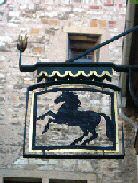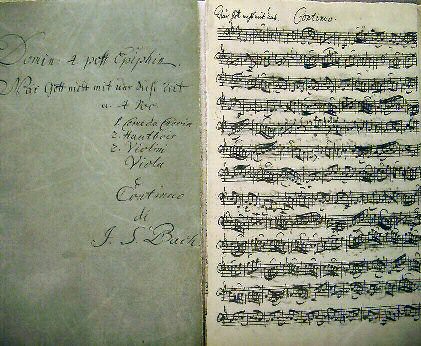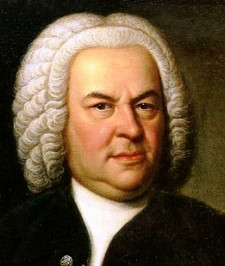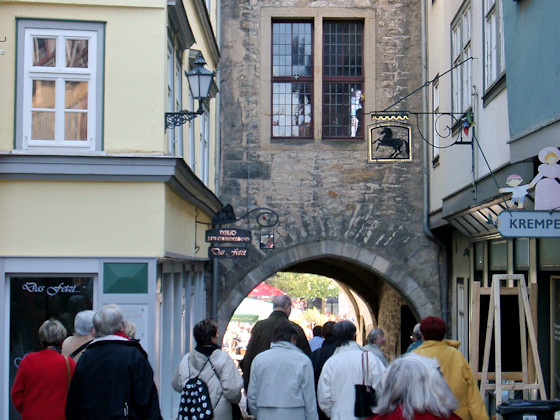Music on this page: Nun komm, der Heiden Heiland,
Cantata No. 61-1 Overture (Choro)
The audio player is located at the bottom
In the beginning was manslaughter
It started with manslaughter
Erfurt, 27 February 1635: A family celebration is taking place in the house "Zum Affen" on the Krämerbrücke. Landlord Hans Rothländer has invited some town musicians to the christening of his youngest son. A soldier is also among the guests. A contemporary chronicler reports that he falls asleep, drunk on wine. The lady of the house wakes him up with the intention of dancing with him...
"Then he rises, takes the brass candlestick and strikes the nearest man three wounds in the head, then grabs his sword and stabs the other man in the back so that he died 12 hours later. The perpetrator was then caught and executed with a sword in the hospital square."
The victims of this attack were two capable town musicians. The terrible story spread like wildfire far beyond Erfurt.
Johann Bach, organist in Schweinfurt in Franconia and grandson of Bach's ancestor Veit from Wechmar, also hears about this. He immediately sees an opportunity to return to Thuringia and makes representations to Christoph Volbrecht, the director of the Erfurt Stadtmusik.
"He had to apply to be a town musician and that meant he first had to prove that he was of honest birth, that he had studied for five years and then he had to pass the musical test, which meant being able to play 10 instruments!"

He is given the house "Zum Schwarzen Ross" on the Krämerbrücke as his home. One of his duties is to play "fine sacred songs" from the city's towers at 10 a.m. on market days. The town musicians also have to play in the churches, both Protestant and Catholic.
From the Krämerbrücke bridge, the Bach family's path leads - both literally and figuratively in a "historical" sense - to the Kaufmannskirche church. This is the place where you can most clearly experience that Johann Bach, together with his brother Heinrich, who also came from Wechmar, founded an entire dynasty of town musicians.
Biography of Johann Sebastian Bach

1685 Eisenach
- born on 21 March as the son of the town piper (Stadtpfeifer, piffaro) Johann Ambrosius Bach
- At the age of 8 attended the Latin school of the Dominican monastery in Eisenach
- 1694/95 Death of parents
1695 Ohrdruf
- Education by his brother Johann Christoph Bach. Bach learnt to play the organ and to compose from him
- 1700 Lüneburg
Singer in the Mettenchor of St Michael's Monastery - 1703 Weimar
Violinist at court

1703 Arnstadt
- Organist at the New Church
- 1705/06 Four-month study trip to Lübeck
1707 Mühlhausen
- Organist at the Divi Blasii church. He also wrote his first cantatas here
- Wedding with Maria Barbara Bach in Dornheim
1708 Weimar
- Organist and chamber musician at the court of Duke Wilhelm Ernst in Weimar. His dismissal earned him four weeks in prison in 1717
- 1714 Appointment as concertmaster with obligation to regularly compose cantatas
- 1717 Collection of chorale preludes for "Orgelbüchlein (organ booklet)" begun
1717 Köthen
- Court Kapellmeister at the court of Prince Leopold von Anhalt-Köthen
- 1720 Death of his wife Maria Barbara
- 1721 "Brandenburg Concerts"
- 1721 Wedding with the singer Anna Magdalena Wilcke
- 1722 "Well-Tempered Clavier" Part I
- 1722 "Piano booklet for Anna Magdalena Bach"
1723 Leipzig
- Thomaskantor, where he was not only responsible for musical duties such as the Sunday cantata performances, but also taught Latin at the affiliated boarding school
- 1724 First performance of the St John Passion
- 1727 First performance of the St Matthew Passion
- 1729 Takeover of the Collegium musicum
- 1733 Presentation of the Kyrie and Gloria of the Mass in B minor to the Dresden court
- 1734/35 First performance of the Christmas Oratorio
- 1747 Visit to the Prussian King Frederick II, "Musical Offering"
1747 Entry into the "Society of Musical Sciences" - Around 1740 to 1750 "Art of the Fugue"
- 1749 In the last years of his life, Bach went completely blind and underwent surgery on both eyes.
- 1750 Completion of the Mass in B minor
- died in Leipzig on 28 July. After being reburied twice, his grave is now in St Thomas's Church in Leipzig.

If you click with the mouse on the picture of J. S. Bach, you can see what he really looked like - a reconstruction based on his skull.
Music example: Nun komm, der Heiden Heiland, Cantata No. 61-1 Overture (Choro)
